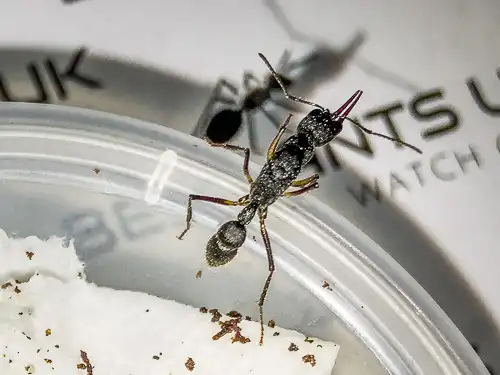Free UK Delivery on orders over £99
Harpegnathos Venator Primitive Jumping Ant
59.99
Harpegnathos Venator aka Primitive Jumping Ant
The world of ants is a fascinating one, with countless species exhibiting unique characteristics and behaviours. One such intriguing species is Harpegnathos venator, commonly known as the Primitive Jumping Ant. These ants, found in various regions in Asia, possess remarkable abilities that set them apart from their counterparts. In this article, we will delve into the world of Harpegnathos Venator, exploring their characteristics, behaviour, and the secrets behind their extraordinary jumping ability.
Characteristics and Behavior of Harpegnathos Venator
One such intriguing species is Harpegnathos venator, commonly known as the Primitive Jumping Ant. These ants, found in various regions in Asia, possess remarkable abilities that set them apart from their counterparts. These ants are known for their relatively large size compared to other ant species, with workers measuring around 16 millimetres in length. Their bodies are predominantly black, and they possess strong mandibles that aid in capturing prey and defending their colonies.
One of the most intriguing aspects of Harpegnathos venator is their unique social structure. Unlike many other ant species, Harpegnathos venator colonies do not have a single queen. Instead, they have multiple reproductive females known as gamergates. These gamergates engage in aggressive battles to establish dominance and secure their position as the primary reproductive females within the colony. This polygynous system is rare among ants and adds to the complexity of their social dynamics.
The Unique Jumping Ability of Harpegnathos Venator
The jumping ability of Harpegnathos venator is truly astonishing. These ants are capable of performing jumps that can reach up to 10 centimetres in length. To be honest, once I looked after these amazing ants and have never seen them jumping more than 5cm when they hunted a locust. This ability allows them to navigate through their environment efficiently, overcoming obstacles and reaching food sources that may be out of reach for other ants. Their eyesight was so good that every time I went into the ant room to see how they were going or feed them, they spotted me when I was three meters away. It was the same situation with the Bull Ants, both have an exceptional vision.
The secret behind their remarkable jumping prowess lies in their powerful hind legs.
These legs are specially adapted for jumping, with elongated femurs and tibias that provide the necessary leverage and strength. Additionally, Harpegnathos Venator possess adhesive pads on their feet, enabling them to grip onto surfaces and generate the force required for their impressive jumps.
How to Care for Harpegnathos Venator: Tips for Ant Enthusiasts in the UK
If you are an ant enthusiast residing in the United Kingdom and are considering keeping a Harpegnathos venator as a pet, there are several important factors to consider. Firstly, it is crucial to create a suitable habitat for these ants. It's important to provide a special substrate, like coco fibre, for instance, to make sure that the larvae can spin cocoons. The queen size is 14 - 16mm Color: head, thorax and gaster black, mandibles and legs reddish brown, thorax enlarged and workers 12-16mm with identical colouration. They are a famous species due to their aggressiveness and especially the fact that they can jump up to 10 centimetres due to evolved leg muscles! They grow slowly and it is hard to start from just a queen so getting one with 10 or more workers has a higher chance of survival. A well-ventilated terrarium or formicarium with plenty of nesting space is essential. Additionally, providing a variety of food sources such as insects to meet their nutritional needs. Once they get their insect prey they eat purely on the hemolymph so do not give them sweets at all as they do not need any. Read tons of information about Harpegnathos Venator on our Blog page.
It is also crucial to maintain the optimum temperature and humidity levels within the ant enclosure. Harpegnathos venator thrives in temperatures ranging from 22 to 26 degrees Celsius and requires a humidity level of around 50 to 70 percent. Regular monitoring and adjustments are necessary to ensure optimal conditions for their well-being.
In conclusion, Harpegnathos venator, the Primitive Jumping Ant, is a truly remarkable species with unique characteristics and behaviours. Their ability to perform impressive jumps, coupled with their complex social structure, makes them a fascinating subject for ant enthusiasts. By understanding their needs and providing suitable care, these captivating creatures can be admired and studied within the confines of a responsibly maintained ant colony.
It is illegal and strictly frowned upon to release these ants into the wild.

